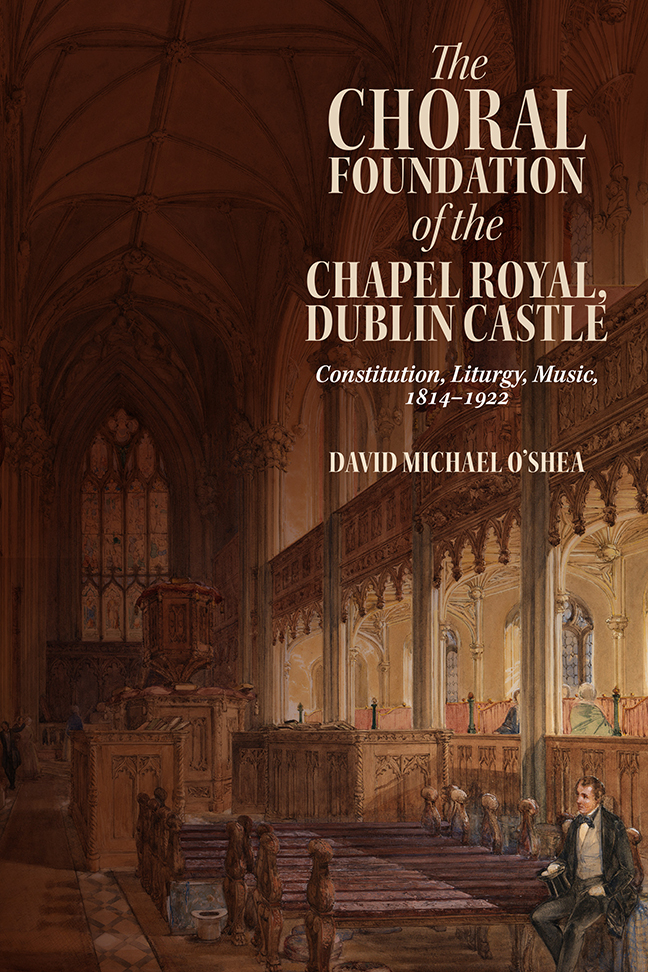Book contents
- Frontmatter
- Contents
- Illustrations
- Foreword
- Preface
- Acknowledgements
- A Note on Terminology
- Abbreviations
- Introduction
- 1 Precedents, Polity and Politics
- 2 Clergy
- 3 Churchmanship, Furnishings and Functions
- 4 The Musical Foundation
- 5 The Chapel Royal Music Collection
- 6 Singing the Liturgy
- 7 Organs
- 8 Boy Choristers
- 9 Gentleman Singers
- 10 Organists and Composers
- 11 The Chapel Royal's Legacy
- Conclusion
- Appendix A Lords Lieutenant, 1801–1922
- Appendix B Clergy of the Chapel Royal
- Appendix C Extant Chapel Royal Music Volumes (RCB MS 1113)
- Appendix D Boy Choristers of the Chapel Royal
- Appendix E Gentlemen Singers of the Chapel Royal
- Appendix F Organists of the Chapel Royal
- Appendix G Fragment of a Juvenile Chant by C. V. Stanford
- Bibliography
- Index
- Irish Musical Studies Previous volumes
11 - The Chapel Royal's Legacy
Published online by Cambridge University Press: 10 January 2024
- Frontmatter
- Contents
- Illustrations
- Foreword
- Preface
- Acknowledgements
- A Note on Terminology
- Abbreviations
- Introduction
- 1 Precedents, Polity and Politics
- 2 Clergy
- 3 Churchmanship, Furnishings and Functions
- 4 The Musical Foundation
- 5 The Chapel Royal Music Collection
- 6 Singing the Liturgy
- 7 Organs
- 8 Boy Choristers
- 9 Gentleman Singers
- 10 Organists and Composers
- 11 The Chapel Royal's Legacy
- Conclusion
- Appendix A Lords Lieutenant, 1801–1922
- Appendix B Clergy of the Chapel Royal
- Appendix C Extant Chapel Royal Music Volumes (RCB MS 1113)
- Appendix D Boy Choristers of the Chapel Royal
- Appendix E Gentlemen Singers of the Chapel Royal
- Appendix F Organists of the Chapel Royal
- Appendix G Fragment of a Juvenile Chant by C. V. Stanford
- Bibliography
- Index
- Irish Musical Studies Previous volumes
Summary
Disestablishment, Home Rule and the path to Irish independence
The building of the Chapel Royal was, as we have seen, an integral part of a post-Union viceregal image-making project. Throughout the nineteenth century, the government's continued investment in the Chapel was imperative for the maintenance of the public image of the viceregal court. The preservation of the Lord Lieutenancy depended on the support of the middle classes, both Catholic and Protestant, nationalist and Unionist, and so the Chapel's role in providing regular interaction between the viceregal court and the general public became increasingly important with the growth of genteel Protestant nationalism after the foundation in 1870 of the Home Government Association, the precursor of the Irish Parliamentary Party. This movement towards a policy of self-government popularly called ‘Home Rule’ dominated Irish politics for half a century.
In spite of the promise in the Acts of Union that the churches of England and Ireland would be joined together ‘for ever’, the Irish Church Act of 1869 legislated for the disestablishment of the Church of Ireland, which was effected from 1st January 1871. This severing of the legal connection between the church and state left the Chapel Royal in an anomalous position. A London musical periodical argued for the Chapel's preservation for the sake of its musical tradition, regardless of the official religion of the state, or the personal faith of the Lord Lieutenant:
There may be a Roman Catholic representative of Royalty in Dublin Castle; an Excellency of this faith must have his chapel, and we presume his will in this matter would produce little or no dissatisfaction.
The author of this piece drew parallels between the English Chapel Royal and the Dublin Chapel, and perhaps unwisely admitted his ignorance of the musical establishment in Dublin:
What has been done by the composers of our English Chapels Royal is known on all sides, but of what has been done in the Irish Chapel Royal we know little or nothing; but we deeply regret to record that there is a possibility of the total abolition of this inestimable foundation in Ireland.
- Type
- Chapter
- Information
- The Choral Foundation of the Chapel Royal, Dublin CastleConstitution, Liturgy, Music, 1814-1922, pp. 213 - 229Publisher: Boydell & BrewerPrint publication year: 2023



